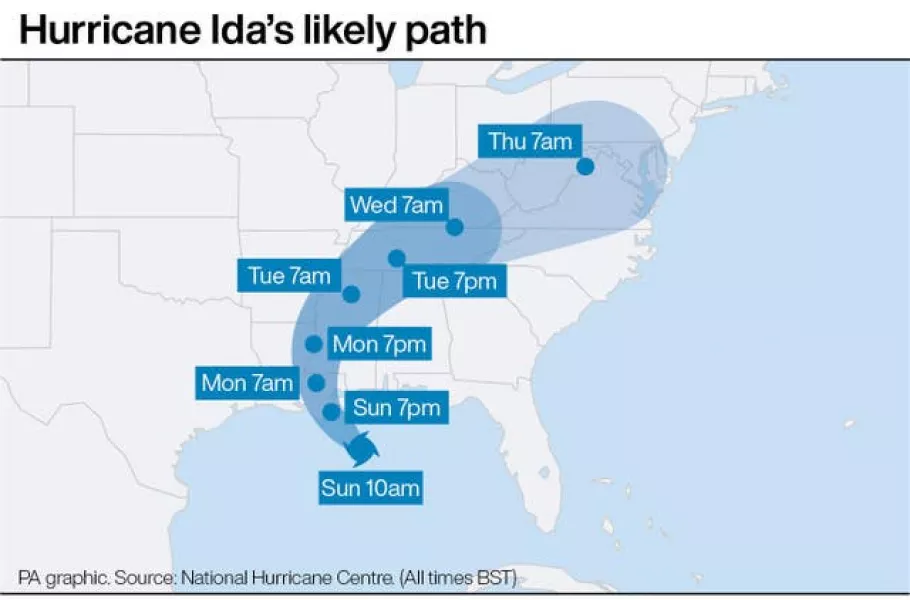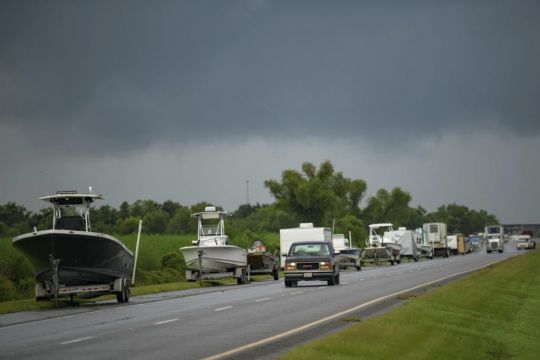Hurricane Ida has grown rapidly in strength, becoming a dangerous Category 4 hurricane hours before hitting the Louisiana coast as emergency officials in the region grapple with opening shelters for displaced evacuees despite the risks of spreading coronavirus.
As Ida moved through some of the warmest ocean water in the world in the northern Gulf of Mexico, its top winds grew by 45mph to 150mph in five hours.
The system is expected to make landfall later on Sunday on the same date Hurricane Katrina ravaged Louisiana and Mississippi 16 years ago.

The National Hurricane Centre said Ida is forecast to hit at 155mph, just 1mph short of a Category 5 hurricane.
Only four Category 5 hurricanes have made landfall in the US: Michael in 2018, Andrew in 1992, Camille in 1969 and the Labour Day Hurricane of 1935. Michael and Andrew were upgraded to Category 5 long after the storm hit with further review of damage.
Ida was centred about 60 miles south of the mouth of the Mississippi River, and 75 miles south-south-east of Grand Isle, Louisiana, and was travelling north west at 15mph.
Ida is threatening a region already reeling from a resurgence of Covid-19 infections, thanks to low vaccination rates and the highly contagious Delta variant.
New Orleans hospitals plan to ride out the storm with their beds nearly full, as similarly stressed hospitals elsewhere had little room for evacuated patients.
As of the 6am CDT @NHC_Atlantic update, #Ida’s sustained winds are now 150mph, with a central pressure of 935mb.
*link to full update: https://t.co/PN4t4ulJzQ?
*Loop from 920pm-540am CDT pic.twitter.com/w0Wg5nzCWq— National Weather Service (@NWS) August 29, 2021
Shelters for those fleeing their homes carried an added risk of becoming flashpoints for new infections.
Governor John Bel Edwards vowed on Saturday that Louisiana’s “resilient and tough people” would weather the storm. He also noted shelters would operate with reduced capacities “to reflect the realities of Covid”.
He said Louisiana officials are already working to find hotel rooms for many evacuees so fewer have to stay in mass shelters.
He noted that during last year’s hurricane season, Louisiana found rooms for 20,000 people.
“So we know how to do this,” Me Edwards said. “I hope and pray we don’t have to do it anywhere near that extent.”
This will be one of the strongest storms to hit Louisiana since at least the 1850s. Preparations need to be complete and you need to be where you intend to ride out the storm by tonight. Conditions will begin deteriorating early tomorrow morning. Stay vigilant. #lagov #lawx #Ida pic.twitter.com/7wkArbd9uo
— John Bel Edwards (@LouisianaGov) August 28, 2021
President Joe Biden approved emergency declarations for Louisiana and Mississippi ahead of Ida’s arrival.
Comparisons to the 2005 landfall of Katrina weighed heavily on residents bracing for Ida. A Category 3 storm, Katrina was blamed for 1,800 deaths as it demolished oceanfront homes in Mississippi and caused levee breaches and catastrophic flooding in New Orleans.
Ida intensified so swiftly that New Orleans officials said there was no time to organise a mandatory evacuation of its 390,000 residents.
Mayor LaToya Cantrell urged residents to leave voluntarily. Those who stayed were warned to prepare for long power outages amid sweltering heat.

Officials stressed that the levee and drainage systems protecting the city have been much improved since Katrina, but cautioned flooding is still possible with up to 24in of rain forecast in some areas.
Mr Edwards said 5,000 National Guard troops are being staged in 14 Louisiana parishes for search and rescue efforts, and 10,000 power workers are on standby to respond to electrical outages.
Ida poses a threat far beyond New Orleans. A hurricane warning was issued for nearly 200 miles of Louisiana’s coastline, from Intracoastal City south of Lafayette to the Mississippi border.
A tropical storm warning was extended to the Alabama-Florida border.

Meteorologist Jeff Masters, who flew hurricane missions for the government and founded Weather Underground, said Ida is forecast to move through “the just absolute worst place for a hurricane”.
The Interstate 10 corridor between New Orleans and Baton Rouge is a critical hub of the nation’s petrochemical industry, lined with oil refineries, natural gas terminals and chemical manufacturing plants.
A US Energy Department map of oil and gas infrastructure shows scores of low-lying sites in the storm’s projected path that are listed as potentially vulnerable to flooding.







